In this article
Choosing the right tree climbing store is a critical first step, whether you’re a seasoned arborist or a rock climber curious about ascending into the canopy. Tree climbing, for professional or recreational pursuits, demands specialized gear quite different from other vertical disciplines. The world of tree climbing stores can seem perplexing with its niche equipment, stringent safety standards, and the varied expertise of retailers. This guide aims to unveil “arborist secrets,” helping you pinpoint the best tree climbing stores, choose gear with an eye on safety and value, and grasp key distinctions, especially if your background is in rock climbing. Making informed decisions on where and what to buy is foundational for safe, efficient, and successful tree climbing.
This article will guide you through understanding the types of tree climbing retailers, the essential gear you’ll need (and how it differs from rock gear), decoding safety standards like ANSI and EN, and vetting stores to find real value. We’ll also offer specific advice for rock climbers making the transition. Let’s climb in.
Understanding the Landscape of Tree Climbing Stores
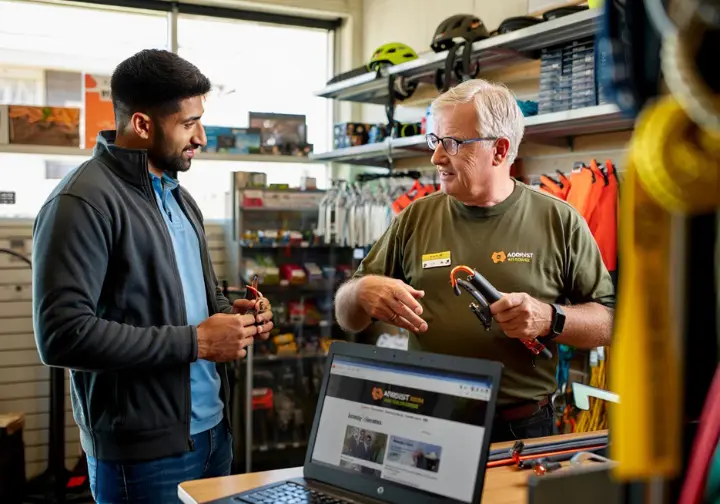
This section differentiates between various types of tree climbing stores, highlighting their pros and cons, and what defines a reputable arborist supplier. This knowledge assists users in identifying retail avenues best suited to their needs, whether they are professionals or recreational climbers.
Types of Tree Climbing Retailers
Online retailers present a vast selection of tree climbing gear, often with competitive pricing and the convenience of home shopping. However, this comes at the cost of a hands-on gear trial; customers depend on product descriptions and reviews. Shipping durations and return policies are significant factors when selecting an online arborist supply store.
Physical brick-and-mortar stores offer the distinct benefit of allowing climbers to inspect and try on equipment like harnesses and helmets before buying. Expert advice from staff, who may be experienced arborists, can be invaluable. Selection might be more limited and prices somewhat higher compared to online options.
Specialist arborist suppliers are dedicated exclusively to tree care and climbing equipment. Their staff often possess deep knowledge in arboriculture. General outdoor stores might stock basic recreational tree climbing items but usually lack the specialized range and expert advice found at dedicated arborist shops. Some manufacturers also sell direct to consumers, occasionally featuring clearance deals on their websites. This can be a good route for specific brands, though selection is confined to that maker’s products. For a look at what some reputable tree climbing gear retailers offer, checking their online presence is a good start. Understanding the benefits of specialized arborist suppliers can also guide your choice.
What Makes a Reputable Tree Climbing Store?
A primary sign of a reputable store is the variety and quality of recognized arborist brands it stocks, such as Petzl, DMM, Teufelberger, and Kask, indicating a commitment to professional-grade equipment. What other brands do you look for?
Knowledgeable staff, ideally certified arborists or seasoned climbers, are vital for delivering reliable, personalized advice. This expertise allows them to help climbers distinguish gear suitable for professional work from that intended for recreational use. The importance of staff expertise in gear stores cannot be overstated.
Excellent customer service, featuring clear return policies, efficient shipping, and effective problem-solving, marks a trustworthy retailer. Transparency in inventory, pricing, and product details, particularly on online platforms, further builds consumer confidence.
A strong community reputation, reflected in positive reviews and active participation in arborist forums, points to a store’s reliability. Shops run by or employing individuals with verifiable experience offer an added layer of assurance. Learning about the qualities of a good arborist supplier helps in making an informed choice.
Essential Tree Climbing Gear: What to Look For in Stores
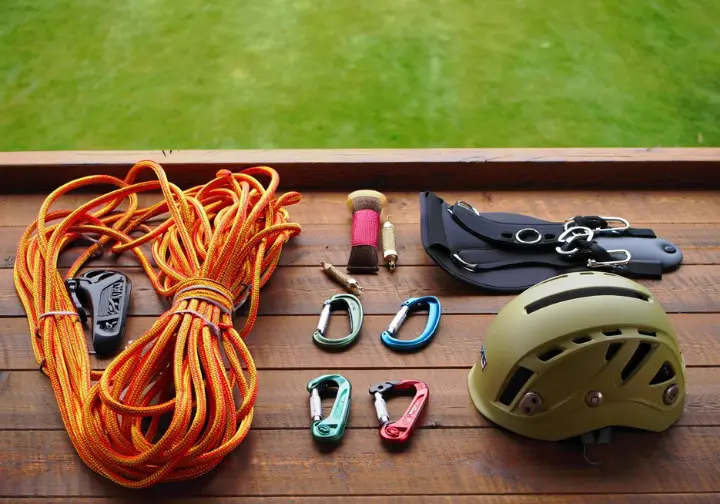
This section explores the main categories of tree climbing equipment available, highlighting differences between professional and recreational requirements. Critically, it explains how tree climbing gear is distinct from standard rock climbing equipment, an understanding vital for safety and function.
Core Climbing Systems: Ropes, Saddles, and Connectors
Tree climbing ropes are typically static or low-stretch, different from dynamic rock climbing ropes, as arborists need a stable line for work positioning. Key considerations include material (polyester, nylon for fiber ropes), diameter, minimum breaking strength (MBS), and kernmantle construction for longevity. Some heavy rigging scenarios might involve wire rope elements, but these are distinct from climbing lines. Common diameters include 11mm, 11.7mm, or 1/2 inch. When considering your setup, understanding rope types for harnesses is a good starting point. You can find more details by researching choosing arborist climbing ropes.
Arborist saddles, or harnesses, are built for comfort during long periods of suspension and work positioning. They have wider waistbands, more padding, and multiple D-rings for tools, distinguishing them from minimalist rock harnesses. Important features of arborist saddles include adjustability and bridge replaceability, and ample gear loops.
Connectors, primarily carabiners and various type shackles, must be locking; auto-locking or triple-action types are preferred for life support systems. They should be rated for arboricultural work, often having higher strength ratings than recreational carabiners. Material (aluminum for lightness, steel for rigging durability, sometimes galvanized steel for corrosion resistance) and shape (oval, D, HMS) are key considerations based on use. For life support, selecting lockable climbing carabiners with appropriate ratings and the correct type shackles for specific rigging setups is paramount for secure anchoring.
Personal Protective Equipment (PPE) and Other Essentials
Helmets are mandatory PPE. For tree work, they often meet standards like ANSI Z89.1 for industrial head protection or EN 12492 for mountaineering helmets, which include side impact protection. While there are overlaps, it’s useful to compare with guides on selecting climbing helmets for broader context. Eye protection (ANSI Z87.1) and hearing protection are also essential, especially when using chainsaws.
Gloves offer grip and protect from abrasions, while specialized chainsaw protective clothing (and understanding safe chain operation if using one) is vital when operating a chainsaw. Durable boots with good ankle support protect feet and aid in climbing. The importance of PPE for arborists should always be a top consideration.
Other vital tools found in tree climbing stores include throwlines and throw weights for line setting, friction or cambium savers to protect the rope and tree, lanyards for positioning, and ascenders/descenders like the Petzl ZigZag. More specialized rigging might occasionally employ items like pelican hooks for specific quick-release needs, but these are not standard for basic climbing.
Spikes or gaffs are tools for tree removals or on trees where bark damage isn’t a concern. They should not be used on live trees meant for preservation due to cambium damage. For those new to these tools, understanding tree climbing spikes is a must.
Gear for Rock Climbers Transitioning to Tree Climbing
While knot knowledge and basic rope handling skills from rock climbing are transferable, key gear differences must be appreciated. Dynamic rock climbing ropes, designed to stretch, are generally unsafe for most tree climbing, which requires static or low-stretch ropes for stable positioning. There are many discussions online regarding gear differences for tree climbing that can be insightful.
Rock climbing harnesses, built for fall-catching and short hangs, lack the comfort, support, and attachment points of arborist saddles needed for extended work positioning in trees. Using a rock harness for tree work can be uncomfortable and less safe for typical arborist tasks where stable anchoring and support are key. You can explore forums for discussions on why rock climbing harnesses differ from arborist saddles to learn from others’ experiences. A foundational step is understanding climbing harness fit and types.
Ascenders and descenders may also differ. Tree climbing often uses specialized mechanical Prusiks or devices designed for single rope technique (SRT) or moving rope systems (MRS/DdRT). Learning how rock climbing ascenders work can provide a basis for comparison.
An “arborist secret” for those transitioning is that trees are living, variable anchors needing different rigging considerations and protection (e.g., cambium savers) compared to inanimate rock. Your choice of anchor and how it’s anchored can significantly impact both tree health and your safety at the bottom of the system or high above. Also, never use climbing spikes on healthy trees you wish to preserve.
Decoding Safety Standards: ANSI, CE, EN in Tree Climbing Stores
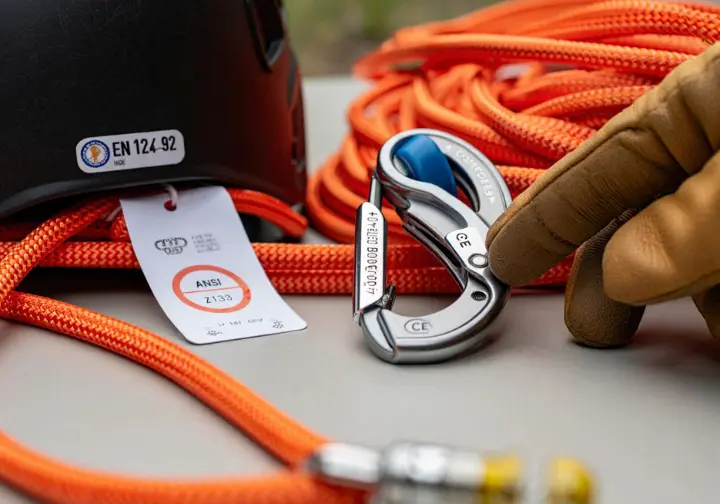
This part clarifies the critical safety standards and certifications—ANSI, CE, EN—that climbers will find in tree climbing stores. Knowing these labels is key to ensuring gear meets demanding safety and quality benchmarks.
Understanding ANSI Standards (Especially Z133)
The American National Standards Institute (ANSI) Z133 is the foremost safety standard for U.S. arboricultural operations. It dictates a broad array of safety needs, including minimum breaking strengths (MBS) for ropes (5,400 lbs) and hardware like carabiners (5,000 lbs) used as a primary link in climbing systems. You can find more details with resources that offer ANSI Z133 safety requirements explained.
While Z133 is an operational standard, equipment might also reference specific ANSI product standards such as Z89.1 for helmets or Z87.1 for eye protection. The ANSI Z359 series for fall protection is stricter, often necessitating third-party testing.
An “arborist secret”: compliance with some ANSI Z133 gear strength aspects can be self-declared by manufacturers. Therefore, looking for third-party verification or additional certifications, like those ensuring a specific link design meets tested strengths, can provide greater assurance of quality and safety testing. For deeper insight, consider understanding product certifications for arborist gear. Reputable tree climbing stores should explain Z133 needs and guide you to compliant gear; staff knowledge here reflects a store’s safety commitment.
Navigating CE Marking and EN Standards
The CE marking (Conformité Européenne) shows a product meets health, safety, and environmental protection standards for items sold in the European Economic Area (EEA). It’s a legal mandate for certain products in the EU and often appears on arborist gear globally. If you’re unsure what CE certification means for products, resources are available online.
Specific European Norm (EN) standards outline performance criteria for various gear types. Examples include EN 1891 for low-stretch kernmantle ropes, EN 362 for connectors (carabiners), where understanding the implications of an open link or gate is critical for safety, EN 358 for work positioning systems, EN 813 for sit harnesses, and EN 12492 for mountaineering helmets. An overview of European standards for arborist PPE can be very helpful.
An “arborist secret” for CE marking: look for the 4-digit number after “CE.” This identifies the “Notified Body,” an independent third party that tested and certified the product, adding assurance. EN standards usually require performance testing and quality system certification for every critical link. Stores stocking international brands will have many CE and EN certified products.
The Role of ISA and TCIA in Gear and Practice
The International Society of Arboriculture (ISA) provides certifications like “ISA Certified Arborist®,” denoting knowledge and experience in tree care. While ISA doesn’t directly certify gear, advice from ISA Certified Arborists, perhaps store staff, is valuable for selection. You can perform a check by verifying ISA arborist credentials online.
The Tree Care Industry Association (TCIA) offers training, safety programs, and accreditation for tree care companies. TCIA Accreditation means a company follows industry standards for safety and ethics, often implying a commitment to quality gear. Information about TCIA accreditation for tree care companies is available on their site.
Both ISA and TCIA significantly contribute to developing safety standards like ANSI Z133. Their resources are useful for understanding safe practices and equipment, including the scope of proper gear use.
Arborist Secrets: Vetting Retailers and Finding Value
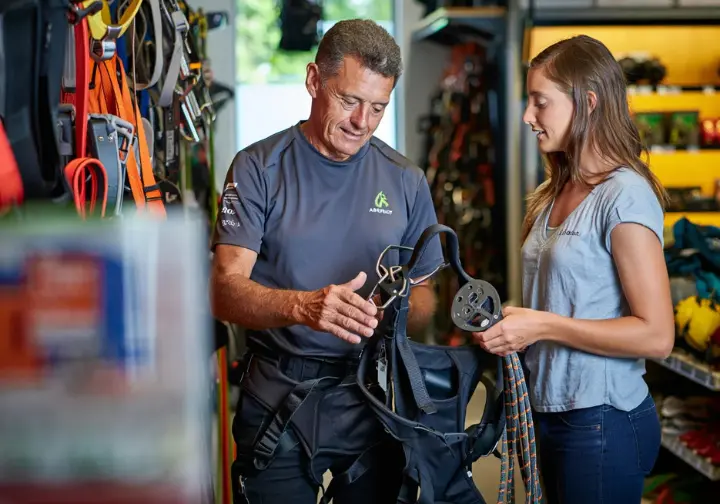
This section offers insider tips—”arborist secrets”—on evaluating tree climbing store expertise, both online and physical. It also covers strategies for finding the best gear value without compromising safety or quality, helping climbers become savvy consumers.
Gauging Store Expertise: Questions to Ask
When speaking with staff, ask specific questions about gear suitability for your intended use—recreational versus professional, or for certain tree types or climbing systems (SRT vs. MRS), and the expected scope of your work. Nuanced answers beyond catalog descriptions suggest genuine expertise.
Inquire about their grasp of safety standards. For instance, can they explain EN 1891 Type A vs. Type B ropes or the implications of an ANSI Z133 rating on a carabiner used as a key link in the system? A knowledgeable retailer can clarify these technicalities. For a glimpse into how specialist retailers present information, you might check the product details or assessing staff knowledge in specialist stores by Browse their site.
An “arborist secret”: ask for recommendations for a complete beginner setup versus a professional one. Listen to how they differentiate needs and justify gear choices, aiming for worry-free anchoring solutions appropriate for each level. This reveals their understanding and safety commitment over mere upselling.
For online stores, review their “About Us” page, staff credentials, and the quality of blogs or product guides. Detailed, informative content often signals deeper expertise. See what to look for in online store information by visiting various retailer sites.
Online vs. Physical Stores: Maximizing Benefits
For online tree climbing stores, seek detailed product descriptions, quality multi-angle images, clear specifications (MBS, certifications), and customer reviews. Reputable online sellers usually have transparent inventory, fair policies, and secure checkout. The online presence and information quality of arborist stores can be a good indicator.
When in a physical store, try on harnesses and helmets for fit and comfort. Handle different types of ropes to feel their texture and stiffness. Check that connections click satisfyingly into place. The advantages of physical arborist supply stores include this tactile experience.
An “arborist secret” for online shopping: check for responsive, knowledgeable customer service for pre-purchase technical questions. Ensure each critical link in your gear selection is well-understood. In physical stores, note if staff ask clarifying questions about your needs. Many climbers blend approaches: research online, then try in-store, or vice-versa for price checks from reputable dealers.
Finding True Value: Budget vs. Premium Gear
The “arborist secret” to value isn’t just the cheapest gear, but the smartest, safest option for your needs. Prioritize investment in critical life-support components like your primary climbing line, harness, and key connectors or any specialized hook; skimping here can have severe outcomes. When investing in quality life-support climbing gear, focus on reliability.
For novices or recreational climbers, “best value” options offer good safety and function without premium professional prices. Avoid extremely cheap gear from non-specialist platforms, as quality and safety can be compromised, especially with something as fundamental as your primary rope. If you’re just starting, looking into essentials for beginner climbing gear can offer a broader perspective on initial purchases.
Consider gear lifespan and durability. Higher-quality, pricier equipment, often made from robust materials like forged steel or utilizing a compact link design for metal components (as opposed to a potentially weaker long link design in some non-rated items), might last longer and perform better under rigorous use, offering better long-term value than cheaper alternatives that wear out fast. There are guides for finding budget-friendly arborist gear that maintain a focus on quality. Look for sales from reputable dealers, ensuring items meet current safety standards and aren’t recalled.
Critical Advice for Rock Climbers Exploring Tree Climbing Stores
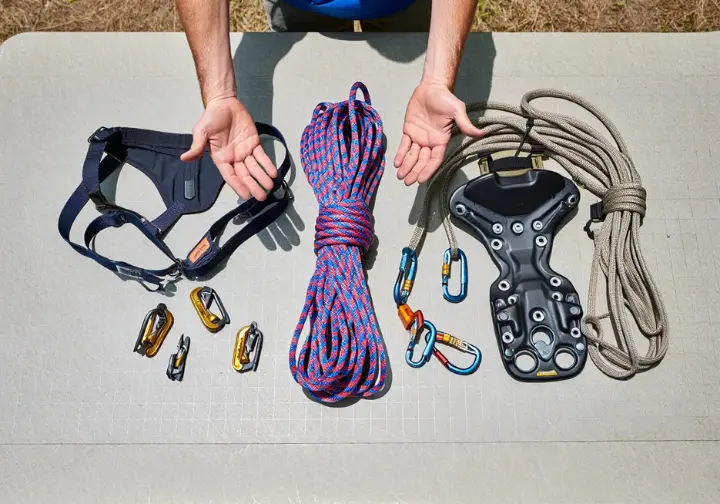
This part is for rock climbers, highlighting unique considerations, gear differences, and safety adjustments for tree climbing and its specialized retail environment. It aims to prevent unsafe assumptions and encourage a safe transition.
Why Your Rock Gear Might Not Cut It (And Could Be Dangerous)
The most vital difference is ropes: dynamic rock ropes stretch to absorb fall forces, which is usually inefficient and undesirable for tree climbing’s need for static or low-stretch lines for positioning. Using dynamic ropes for arborist work causes excessive bouncing. A proper arborist rope is essential. There are forum discussions detailing the dangers of using dynamic ropes for tree climbing. It’s critical to use professional climbing ropes for tree work.
Rock climbing harnesses focus on lightweight design and fall-catching. Arborist saddles, however, are built for prolonged suspension, work positioning, and carrying tools, offering more comfort and attachment points, including sturdy hooks or loops for gear. A rock harness can be very uncomfortable and potentially less safe for typical tree work scenarios where the climber is anchored for extended periods. Understanding specialized equipment for tree climbing is key.
Many rock carabiners, while strong, might not meet specific gate requirements or ANSI Z133’s 5,000 lbs strength rating for arborist life support systems, which may also incorporate specific type shackles for certain connections. Arborist connectors often feature triple-action auto-locking gates for enhanced security and a reliable hook-up to the system.
An “arborist secret”: trees are living, dynamic anchor points that interact with gear differently than rock. Techniques like using cambium savers protect both the tree and the rope, a consideration for every anchor setup not usually present in rock climbing. For a general overview, you can explore resources that outline transferable skills and critical gear differences for tree climbing.
Finding the Right Entry-Level Tree Climbing Setup in Stores
When visiting a tree climbing store as a rock climber, clearly state your experience and specific interest (e.g., recreational tree climbing, not professional work). This helps staff suggest suitable entry-level gear focused on safety and ease of use, including the right length of rope. Knowing the differences by distinguishing recreational vs professional tree climbing gear will help you communicate your needs.
Look for beginner-friendly recreational tree climbing kits if offered. These often bundle essential components like a suitable static rope, an arborist-style saddle, basic connecting links, a friction hitch, and a helmet. For example, some retailers offer beginner recreational tree climbing kits.
Concentrate on understanding each new piece of gear’s function. Ask staff to explain items like friction savers or a specific arborist hitch, or even a simple hook, and why they are used in tree climbing. There are also general guides on essential gear for beginner tree climbers.
An “arborist secret” for beginners: invest in quality, certified foundational gear (saddle, rope, helmet, primary connector or shackle) and perhaps start with simpler, widely accepted climbing systems before moving to more complex mechanical devices. Quality training is as vital, if not more so, than the gear itself for achieving worry-free anchoring and safe ascents from the bottom of the tree to the top. The principles of learning to climb safely are always relevant.
Conclusion: Climbing Trees Safely Starts with the Right Store and Gear
Navigating tree climbing stores well means understanding specialized equipment, prioritizing safety standards like ANSI and EN, and knowing how to evaluate retailer expertise—especially if you’re coming from rock climbing. “Arborist secrets” guide you to look beyond price for true value, invest in quality life-support gear from reputable sources, and grasp the crucial differences between tree and rock climbing equipment for safety, ensuring every hook-up to an anchor is secure.
For rock climbers moving into tree climbing, recognizing transferable skills while adopting new, discipline-specific gear—particularly static ropes and arborist saddles—and safety protocols is essential for a secure and enjoyable experience with each anchored position. Always seek expert advice, choose certified gear, invest in proper training before your first tree climb, and perform thorough pre-use gear checks. By approaching tree climbing stores with informed diligence, you can select the right equipment confidently, fostering a deeper appreciation for this unique vertical world and ensuring your canopy adventures are both rewarding and secure.
Frequently Asked Questions about Tree Climbing Stores
What is the single most important piece of advice for a rock climber looking to buy tree climbing gear? >
Are online tree climbing stores trustworthy for buying critical safety gear? >
How can I tell if a tree climbing store has genuinely knowledgeable staff? >
What does ANSI Z133 or an EN number on gear actually mean for me? >
We are a participant in the Amazon Services LLC Associates Program, an affiliate advertising program designed to provide a means for sites to earn advertising fees by advertising and linking to Amazon.com. As an Amazon Associate I earn from qualifying purchases. We also participate in other affiliate programs. The information provided on this website is provided for entertainment purposes only. We make no representations or warranties of any kind, expressed or implied, about the completeness, accuracy, adequacy, legality, usefulness, reliability, suitability, or availability of the information, or about anything else. Any reliance you place on the information is therefore strictly at your own risk. Additional terms are found in the terms of service.











